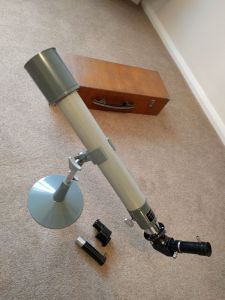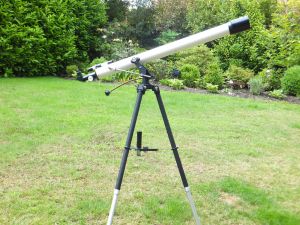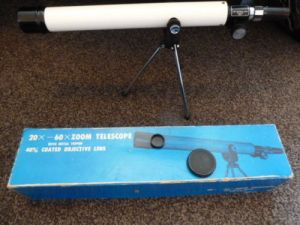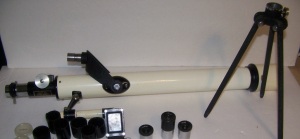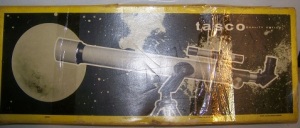My latest purchase is the SkyMax 102 made by skywatcher that i bought for the princely sum of £60.. bargain :). Brand new..the only downside was it had been dropped but i was assured by the vendor that it was still in good collimation. The day it arrived i threw in an eyepiece and lined up a red dot finder ready for the first clear night.
The Test
The clear night duely arrived 3 days ago and i got to test it.. using a 32mm plossl everything looked good and the view was almost exactly the same as my Celestron 80×900 refractor fitted with a cheapo 25MA eyepiece, so far so good. The OTA had been cooling for over an hour so i decided to try a few doubles, thats when i realised something wasn’t quite right!
Defocusing the stars revealed miscollimation that wasn’t present in the 32mm, that view was perfect with excellent symmetrical diffraction rings! i was using my trusty Celestron zoom EP which appeared to be okay from 24mm to around 16mm but then things got messy. At first i thought it may be “seeing” or not enough cooldown, so i tried the zoom in the 80mm refractor. The views were spot on.. so what was wrong with the Mak?
I spent the rest of the evening on the 80mm refractor, the Mak could be dealt with another time. The vendor had said the corrector cell (objective cell for us refractor lovers) had been removed to check for damage as there was a small dent in the lip of the cell. I wondered if there was any damage myself so i packed the gear away and took the Mak indoors to check it over. Disaster?? maybe… closely checking the cell revealed that it wasn’t sat straight, there was a 1mm gap on one side of the OTA where the cell sat flush with the tube at the end of it’s threaded section. This meant recollimating the Mak…. which for some reason is considered either unnecessary or a return to manufacturer situation by most people on the Astro forums. The devil on my shoulder said..”go on, it was only £60,.. it aint workin so fix it!”. I buy a lot of damaged/second hand scopes and i’ve seen all sorts of things that can easily be fixed or are a dead loss. I was hoping that the Mak that i bought primarily to be a travel scope would be fixable… first step is to find out how to get it apart without damaging anything.
The Problem
Consulting the internet and it’s vast wealth of info revealed one simple fact… Mak owners don’t like to mess with their gear! Eventually i found a collimation guide for an Orion Mak that closely resembled the Skymax 102. The rear cell has the same 6 screws (3 push/3 pull) and the collimation was akin to adjusting the primary on a Newtonian, all done by eye looking down the focuser tube. Great… in went the collimating tube, twiddle the allen keys and i managed to get a concentric reflection like the Orion guide had shown. All i had to do now was wait for the next clear night so i could star test it.
Back on the tripod and Polaris centred… the big reveal!… it was worse!! how could this be? so i twiddled the allen keys and got something like but not great. Back to the drawing board!
Indoors i decided that stripping the OTA down was now a necessity rather than an option. Off came the front cell, then holding the tube upright with the focuser at the bottom i removed the focus knob and then the 3 larger allen bolts. I had the backplate in my hands and now it was time to start measuring everything in an attempt to see where the misallignment was. just turning the backplate it wasn’t too obvious that the mirror was tilted, measurements made the tilt just over a millimetre on one side! thats why things were so messy and the tilted primary meant that the 1mm gap at the front cell was throwing everything out. At this point i was hoping the “drop” the tube had suffered hadn’t stretched the threads that hold the front cell. Measuring the OTA showed that everything was square as far as alignment was concerned so the answer must be a tilted corrector!
Noted all the symptoms, targeted the problem, now to see if it can be cured. The corrector cell is like those found in binoculars, a holder that the corrector sits in with a threaded ring holding it in place. Now onto the next problem, the cell “dent” is where the threaded ring screws out… Hmmmm only one way to remove the ring and that means knocking the dent out of the cell… with the corrector lens in place.. eeeek!! and trying to do it without ruining the threads! sounds like a nightmare but i had no option. I know that hitting a lens cell can make it go “out of round” so i needed to put it back in the OTA.. this would also help to hold the corrector while i hammer it.. sounds barbaric.. but i know how to be gentle when the need arises.
The Fix
A piece of wooden dowel, a good hammer, a workmate (portable workbench) and some spacers to keep the tube level. Now it’s time for the dirty work.. tap,tap,tap the wood was compressing, so i rooted out an aluminium drift and started again. It was straightening the dent but marking the threads, ah well… the threaded ring will cut some new ones on its way out.. almost there.. then i noticed something!, the ring isn’t sat directly on the lens.. Closer inspection revealed a rubber o-ring or seal between the ring and corrector lens.. and it wasn’t located properly!
I very carefully pushed it into place and i heard a tiny “clunk” sound. Was that the corrector relocating itself.. must have been! theres nothing else that could move. Back indoors and time for the sighting tube.. collimation was definitely out, but the opposite side to before. i carefully adjusted the rear cell ’til it was looking good.. now to wait for nightfall and hopefully clear skies.
The Result
The star test was great in the 32mm.. minor adjustment brought perfect diffraction rings.. then the jump to 12mm.. slightly out but again a minor twiddle and it was perfect.. i spent around 2 hours just around Lyra and Cygnus. The double double wouldn’t split.. 12mm gives 108x which wasn’t enough. In my light polluted environs i can cleanly split Epsilon Lyrae at around 130-150x with my 80mm refractor, i get figure 8 at around 120x. so i popped in a 9mm which gives 144x in the Mak with it’s 1300mm F/L, the result was a little untidy.. but the split was there!! success!! sort of 🙂
It was 1.20 am and time to pack away.. i had my allen keys in hand and should have done the final collimation there and then.. but didn’t. That’ll have to be tonight.. weather permitting.
Final Thoughts
The reason for purchasing the Mak was purely based on need of a good,cheap,portable scope that i could use for double stars and planets. Something with long focal length but compact size. My first thoughts were to go for a Meade ETX, High cost and mixed reviews put me off, others had reported all sorts of issues with the mounts and drives along with collimation issues. I had thought of the ST80 refractor.. but again short focal length was going to limit double star observing. The 102 Mak seemed to tick all the boxes, and it does now i have it collimated. Performance wise it’s almost exactly the same as my 80×900 Celestron. Using a 32mm in the mak gives 40x mag and beautiful views, the celestron with a 25mm MA gives 36x and is comparable to the Mak. The Mak does however show slightly fainter stars but only just. The Skymax 102/ F12.74 is really the equivelent to an 80mm F11 refractor. This is what i was hoping for in a travel scope. I did own a Celestron Travelscope70 for a while which was great until 100x mag which was about it’s limit. The long f/l refractors have always been a favourite so finding the same performance in such a small package has really cheered me up… now it’s fixed 🙂
I will probably set up a page with pics for the collimation side of things. There’s practically no info on these small maks other than the manufacturer blurb, so it may be of use to others.. stay tuned.

